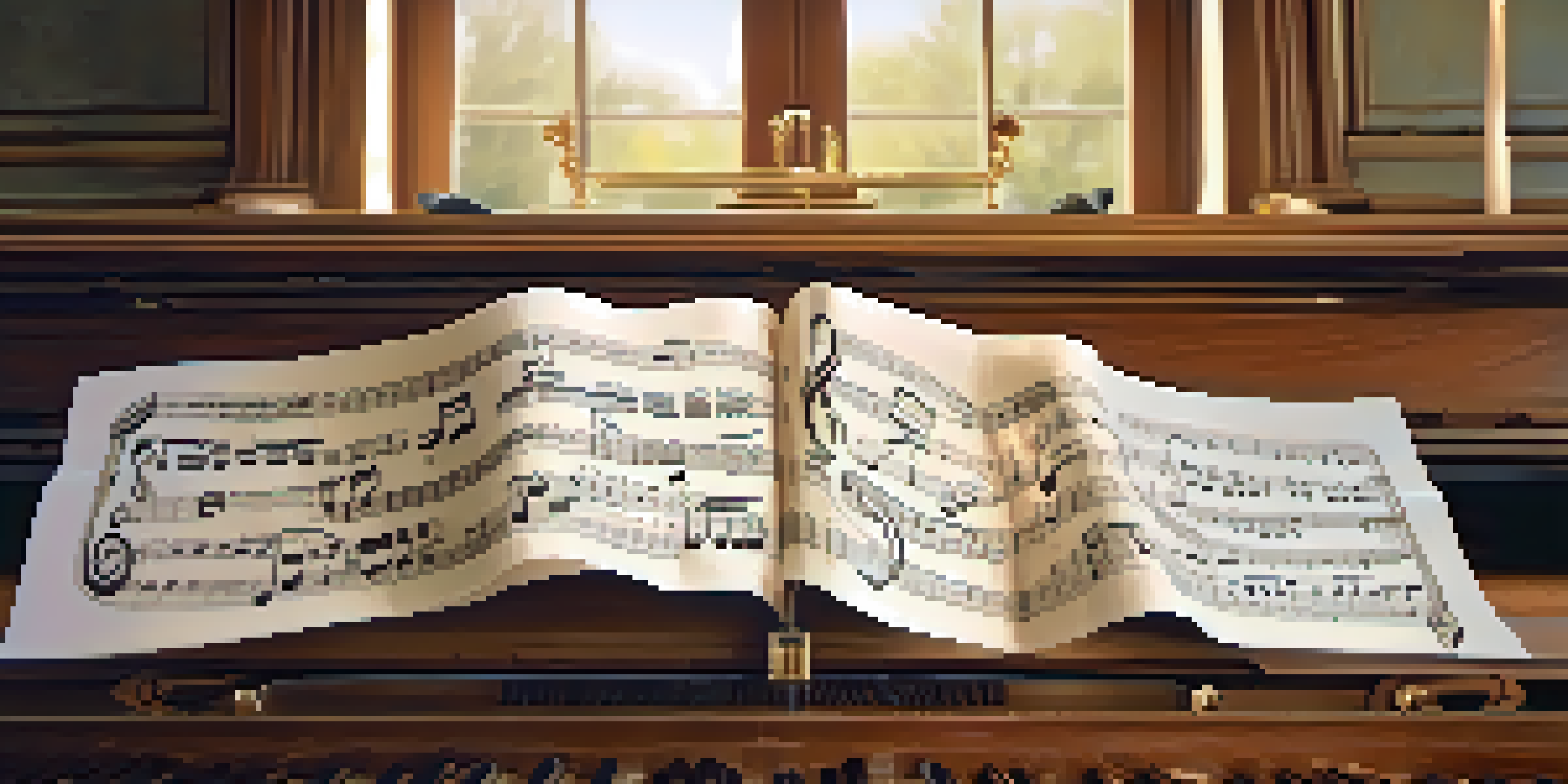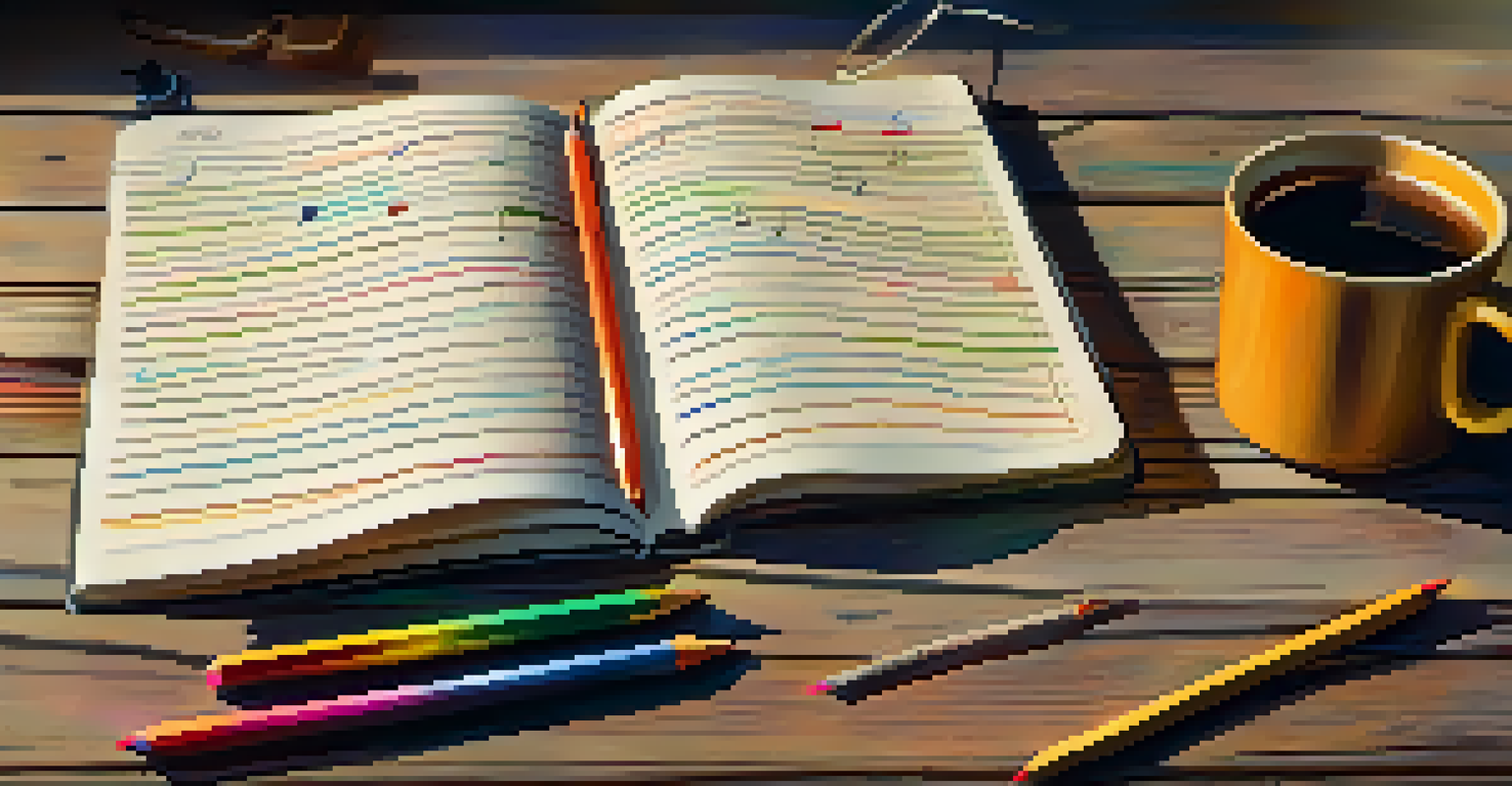How to Write Music: Basic Principles of Music Notation

Understanding the Basics of Music Notation
Music notation is a system that allows musicians to communicate their ideas on paper. Think of it as a written language for music, where notes represent pitches and rhythms translate to timing. Just like learning the alphabet is the first step to writing, understanding music notation is crucial for composing.
Music is the shorthand of emotion.
At its core, music notation uses symbols to indicate how music should be played. Notes, rests, clefs, and other symbols work together to convey the composer's intentions. For example, a quarter note looks different from a half note, and this visual difference helps musicians interpret how long to hold each sound.
When starting out, it's helpful to familiarize yourself with the staff, which consists of five lines and four spaces. Each line and space represents a different pitch, much like different keys on a piano. By learning where each note sits on the staff, you’ll be well on your way to writing your own melodies.
The Role of Clefs in Music Notation
Clefs are symbols placed at the beginning of the staff that indicate which pitches correspond to the lines and spaces. The most common clefs are the treble clef, used for higher pitches, and the bass clef, which is for lower pitches. Understanding these clefs is key to reading and writing music effectively.

For instance, in the treble clef, the second line from the bottom represents the note G, while the bass clef identifies the second line as B. This distinction helps musicians choose the right clef for their instrument or vocal range, ensuring the music sounds as intended.
Basics of Music Notation Explained
Music notation serves as a written language for musicians to communicate pitches and rhythms effectively.
As you delve deeper into music notation, you’ll encounter other clefs like the alto and tenor clefs, which serve specific purposes. Each clef provides a unique perspective on the same notes, allowing different instruments to play in their optimal range. Mastering clefs is essential for any budding composer.
Notes and Rests: The Building Blocks of Music
Notes are the heart of music notation, representing the sounds you want to produce. Each note has a specific shape that indicates its duration, whether it's a whole note, half note, or eighth note. Understanding these shapes helps you convey the rhythm of your music accurately.
Without music, life would be a mistake.
On the flip side, rests are just as important, indicating moments of silence in your composition. Just like a pause in conversation can emphasize a point, rests in music can create tension or allow for reflection. Knowing when to include rests can enhance the overall feel of your piece.
When writing music, balancing notes and rests is crucial for creating engaging compositions. They work together to form phrases and sections, guiding the listener’s experience. As you practice, pay attention to how different rhythms impact the mood and flow of your music.
Time Signatures: Keeping the Beat
Time signatures tell musicians how to count the beats in a piece of music. Typically written as a fraction at the beginning of a staff, the top number indicates how many beats are in a measure, while the bottom number shows which note value gets the beat. Common time signatures, like 4/4, are foundational for many genres.
For example, in a 4/4 time signature, there are four beats per measure, and the quarter note gets one beat. This structure gives your music a sense of timing and organization, making it easier for performers to follow along. Understanding time signatures can greatly influence the rhythm and flow of your composition.
Understanding Clefs is Essential
Clefs indicate which pitches correspond to the lines and spaces on the staff, crucial for reading and writing music.
As you experiment with different time signatures, you’ll discover the unique characteristics they bring to your music. Whether you choose the steady pulse of 4/4 or the waltz-like feel of 3/4, each time signature shapes the listener's experience. This allows you to create varied and interesting pieces.
Dynamics: Adding Emotion to Your Music
Dynamics in music notation indicate how loudly or softly a piece should be played. These markings, such as 'piano' (soft) and 'forte' (loud), help convey emotion and intensity within a composition. Just as a painter uses different colors to evoke feelings, musicians use dynamics to enhance their storytelling.
For instance, a sudden shift from soft to loud can create excitement or surprise, while a gradual crescendo can build tension. By incorporating dynamic markings into your music, you guide performers on how to express the music's emotional content, drawing the listener in.
Experimenting with dynamics can transform a simple melody into a powerful piece. As you write, consider how varying volume levels can affect the overall impact. Remember, dynamics are your tool for crafting an emotional journey through sound.
Articulations: Shaping the Sound
Articulations are symbols that instruct musicians on how to play specific notes, influencing the character of the sound produced. Markings like staccato (short and detached) or legato (smooth and connected) change how a melody is interpreted. Just as a chef might add spices to enhance a dish, articulations add flavor to your music.
For example, a staccato note creates a playful, bouncy feel, while legato can evoke a sense of flow and continuity. By incorporating articulations, you give performers insight into your musical intentions, allowing for a more nuanced performance.
Dynamics and Articulations Matter
Dynamics and articulations add emotional depth and character to music, guiding performers in conveying the composer’s intent.
As you compose, think about the emotions you want to evoke and choose articulations that align with your vision. The subtle touches provided by articulations can elevate your music, making it more engaging and expressive.
Putting It All Together: Writing Your First Piece
Now that you understand the basics of music notation, it’s time to start writing your own piece! Begin by sketching out a simple melody using the notes and rests you’ve learned. Don’t worry about perfection; the goal is to express your musical ideas on paper.
Next, consider the time signature that best fits your melody. Will it have a steady 4/4 pulse, or perhaps a waltz feel with 3/4? Choose a time signature that complements your composition, and then add dynamics and articulations to give it character.

Finally, play your piece on an instrument or using music software to hear how it sounds. This feedback is invaluable as you refine your work. Writing music is a journey filled with creativity and exploration, so enjoy the process and let your unique voice shine through!